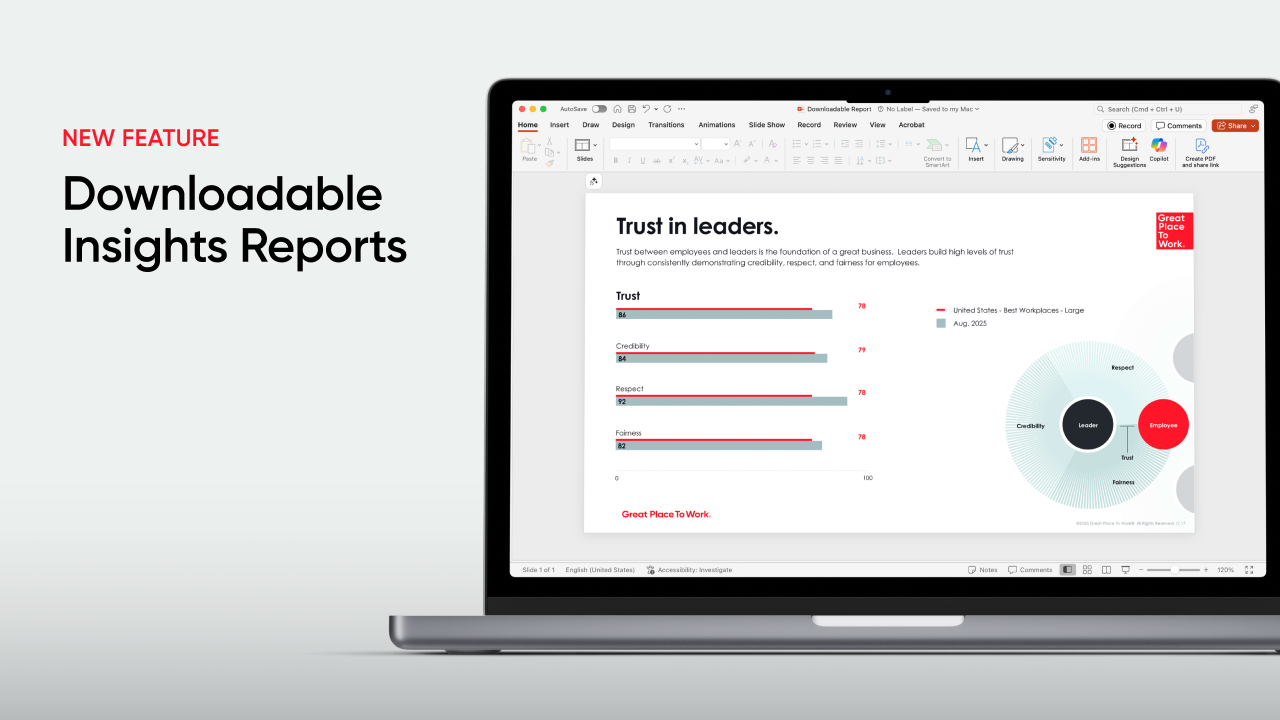Employee Experience, Productivity
Here’s what the data says about experiences that boost employee performance, according to 1.3 million employees.
Gone are the days when companies were valued for their growth rate more than their ability to turn a profit.
Great business leaders in this environment are laser-focused on productivity. One measure worth tracking? Revenue per employee, where the Fortune 100 Best Companies to Work For® outperform the market by 8.5 times.
Here’s how great workplaces inspire employees to give the extra effort that juices productivity, and why maximizing performance is so important for companies in the current business environment.
Why should HR leaders care about productivity?
Unproductive labor can have a surprising price tag. The average annual cost to a company for every hour of “unproductive labor” is $15,000, according to McKinsey.
Labor is often one of the biggest costs for any business, and those costs are only getting more expensive. Data from the Bureau of Labor Statistics in the first quarter of 2025 found that the cost of labor was outpacing productivity gains. For companies, that means that people were getting more expensive, even as they were generating less revenue for their organization.
If those trends keep up, it will be hard to stay in business.
Other factors are contributing to the rising cost of labor. The cost of benefits like health care coverage are growing, and 21 states increased their minimum wage in 2025.
The only answer for business leaders is to generate more revenue faster than the rising cost of labor to produce that revenue.
Labor and associated costs should fall squarely in the HR leader’s wheelhouse. An HR leader who can help people thrive and perform, generating unquestionable business results, is someone that every business needs, and someone that investors are keen to find.
How employee experience is connected to productivity
Employee experience is how workers feel about their workplace and the relationships they have with leaders and colleagues. These relationships are built on trust — and higher levels of trust in your workforce foster a bevy of helpful business outcomes: more agility, more innovation, etc.
Trust starts with leaders, and leaders shape the experiences that allow employees to do their best work. When employees feel they have the trust of their leaders, they, in turn, take more ownership of their work. They take more risks and are more likely to learn new skills. They are more engaged in activities that go beyond their job description.
When employees have a poor experience — they feel isolated, overlooked, underappreciated, or belittled — they don’t give their best effort. They might leave the organization, or if they stay on the job, are less likely to take on additional responsibility.
What 6 experiences inspire employees to give extra effort?
If trust starts with leaders, the first step toward inspiring employees to give extra effort is to embrace a different kind of leadership. Instead of “command and control,” leaders should think about how they can coach and mentor their people.
Above all, listening is an invaluable exercise. It requires leaders to be humble, to accept vulnerability, and to question their assumptions about how employees experience the workplace. As a result, leaders can build trust that drives higher levels of performance.
Great Place To Work® research found six experiences that drive higher levels of discretionary effort for employees across all industries:
1. High levels of cooperation
When employees feel that it is easy to cooperate and collaborate, they are 720% more likely to give extra effort, according to Great Place To Work surveys.
To create this cooperative culture, leaders communicate a consistent direction for the company and work hard to ensure alignment. “What you see is that leaders have a clear direction for the company,” says Sarah Lewis-Kulin, vice president of global research and recognition at Great Place To Work. “People are encouraged to innovate and find better ways of doing things, and there’s great communication.”
At great workplaces, a cooperative culture is one where promotions and recognition are awarded fairly and transparently. Employees have shared definitions of success, and open communication around company goals and expected behaviors. They can find a mentor who takes time to help them develop. They get support to try new ideas and are inspired to take on stretch assignments and take risks.
This creates a sense of purpose, an understanding that one employee’s success doesn’t come at the expense of someone else on the team. Instead, employees feel they have the tools to participate fully in a shared mission — and trust that their contributions will be celebrated and rewarded. People offer to help get a project across the finish line, even when the task at hand isn’t in their job description.
2. Meaningful work
Purpose is an important driver of performance. When employees feel that their work has meaning and is more than “just a job,” they invest more energy in its success.
When employees say their work is meaningful, they are 52% more likely to give extra effort.
At Jackson Healthcare, employees are asked on their first day at the company about the kinds of service that would be most rewarding. The company then works hard to empower employees with the tools they need to get involved, both in their jobs and in their personal time. The vice president of community impact invites every new hire to a one-on-one coffee chat to hear their story and discover ways to get them involved, when and how they want.
3. Every employee gets special recognition
Employee recognition is an important aspect of culture, but often overlooked is whether every employee in the organization has the opportunity to be thanked and rewarded for their contributions.
When employees say everyone can get special recognition, they are 56% more likely to give extra effort. Examples of how companies can ensure everyone gets recognition include practices like Hilton’s “Court of Cleanliness,” which celebrates excellence for housekeeping staff, or efforts like NBCUniversal making recognition more visible with always-on platforms.
4. Fair pay across your workforce
When employees feel they are fairly rewarded for their contributions, they are 46% more likely to give extra effort.
What does it look like to rigorously pursue making compensation fair and equitable? Consider Kimley-Horn, where pay is regularly evaluated, adjusted, and communicated.
Regional HR teams review a master list of all salaries in each region where the company operates and, working with the company’s affirmative action officer, the team analyzes pay parity by gender and minority status. If disparities are found, corrections are made.
For bonus awards, there are four levels of review, from direct manager up to a companywide analysis, to ensure that what can feel like a subjective judgment has met rigorous standards. The process, which Kimley-Horn completes twice a year for its two separate bonus windows, takes two months.
5. Community engagement that inspires your workforce
Engaging employees in giving back to the community can also inspire more engagement and productivity.
When workers feel good about how their company affects their community, they are 37% more likely to give extra effort, per Great Place To Work data.
Companies like DHL, Salesforce, and Mastercard make it a priority to engage employees in volunteering and other social impact efforts. DHL Group celebrates Global Volunteer Day for a two-week period across its global workforce in September and October. Mastercard uses its internal talent marketplace to help employees find volunteer opportunities where they can use their unique skills to help charitable organizations.
Salesforce built its own internal platform to organize and promote volunteer opportunities called “Volunteerforce.”
6. Increased confidence in leadership
When employees say they have a high level of confidence in their leaders, they are 38% more likely to give extra effort.
What builds confidence in leadership? Trust. The top driver of confidence in leadership may vary depending on where you live in the world. In the United States, fair promotion practices are the top driver of confidence in leadership. In Asia, the top driver is having management show a sincere interest in employees, including their lives outside the workplace.
Leaders can also undermine trust with some common mistakes. Some leadership decisions can also threaten to break trust, such as layoffs, but there are ways to handle tough decisions that still preserve trust across an organization.
Other drivers of employee discretionary effort
These six drivers are the strongest answers for what drives discretionary effort according to the data, but other aspects of company culture require attention.
Opportunities for career growth are also key motivators for employees and are a part of a fair work environment. Perceptions of fair pay, for example, don’t always come down to compensation. Employees are also looking to share in the non-monetary rewards of a successful business, including career growth.
Employees also want a workplace with psychological safety, work-life balance, and support for their overall well-being. These factors can have a direct impact on how employees invest their energy, take reasonable risks, and pursue growth opportunities.
How to enhance employee experience to boost productivity
Creating a great employee experience requires constant attention and careful monitoring. Great workplaces are continuously listening for employee feedback and fine-tuning their culture to meet the specific needs of their people.
That means starting with data: Use employee surveys like the Great Place To Work Trust Index™ to measure perceptions of trust, pride, and camaraderie among your employees. Benchmark your performance to the Best Workplaces™ and track your progress year over year.
When you find opportunities for improvement, communicate transparently with your team about where you fall short and how you intend to address the gap. Use action plans with specific timelines to encourage accountability.
For companies that embrace company culture as a competitive advantage, the results can be profound. Companies that build the most trust outperform the stock market by 3.5 times.
Measure productivity with Great Place To Work
Great Place To Work research shows that productivity increases are the product of creating a great workplace culture.
Start your journey to identify where your culture supports growth and where you have opportunities to improve your performance. Discover the drivers of productivity at your company with Great Place To Work’s survey platform.











